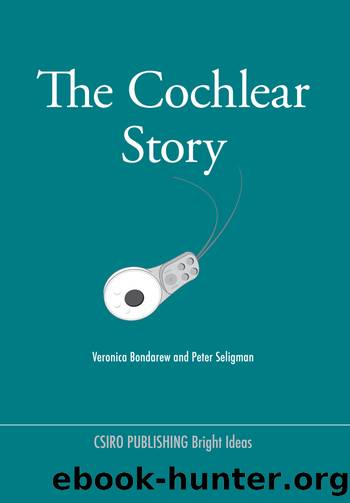The Cochlear Story by Bondarew Veronica;Seligman Peter;

Author:Bondarew, Veronica;Seligman, Peter;
Language: eng
Format: epub
Publisher: CSIRO Publishing
CHAPTER 9.
Without surgeons it was just clever engineering: Bill Gibson
With the completion of the commercial design and manufacture of the implantable device, it was time to change the focus from engineering to the patient. ENT surgeons in Australia and around the world were key to the connection. They championed the promotion of the device and struggled to garner support for the acceptance of a multi-channel cochlear implant that could give speech recognition to the profoundly deaf.
As in other parts of the world, there was opposition from the Deaf community. In Australia attempts were still being made to teach deaf children to speak but there were shifting ideas on the most appropriate thing to do. Lip-reading alone was not sufficient as only 30% of words can be lip-read. The lip-reader must use these words as clues to the meaning of the conversation. It is like doing a constant crossword puzzle, something that many cannot do. So acoustic devices were developed to aid those with hearing loss. Although hearing aids improved over the years, they could only amplify residual hearing. They could not provide sufficient amplification for the profoundly deaf. Even with powerful hearing aids, the higher frequencies typically canât be heard. A deaf person hears vowel sounds but not the consonants. For example, if someone says, âShe goes shoppingâ the deaf person hears, âHe go hoppinâ, copies the sounds and speaks with those sounds, thus listeners can become confused. An auditory oral approach was popularised in the 1950s and 1960s. Children were forced to sit on their hands to prevent them signing. They were taught to use lip-reading and tactile clues, to learn to speak. It was a disaster. With few exceptions, for example if a parent were prepared to spend countless hours working with their child, most children developed only poor speech which could not be understood.
In Australia in the 1970s and 1980s, it became politically correct again to allow deaf children to use sign language. As it was realised that most deaf children who only signed had very poor reading and writing skills, a method called Total Communication was developed. The children had to use signed English in which every word is signed in grammatical context. This is very slow and cumbersome. The deaf children were also expected to learn some speech using hearing aids. When they left school they usually threw away their hearing aids and enjoyed using fluent sign languages such as Auslan (Australian Sign Language).
Professor William Gibson had always been interesting in the ear and its workings. He was born in a town in Devon, England and trained in London to become an ear, nose and throat surgeon. He became interested in cochlear implants through a program called Project Ear, which promoted the concept of cochlear implants. He was further impressed in 1982 when he met Graeme Clark at the Royal Society of Medicine and they discussed Clarkâs project in Melbourne.
Gibson had an identical twin who had married an Australian woman and, during a visit to Australia, Gibson and his family decided that it wouldnât be a bad place to live.
Download
This site does not store any files on its server. We only index and link to content provided by other sites. Please contact the content providers to delete copyright contents if any and email us, we'll remove relevant links or contents immediately.
| Automotive | Engineering |
| Transportation |
Whiskies Galore by Ian Buxton(41509)
Introduction to Aircraft Design (Cambridge Aerospace Series) by John P. Fielding(32876)
Small Unmanned Fixed-wing Aircraft Design by Andrew J. Keane Andras Sobester James P. Scanlan & András Sóbester & James P. Scanlan(32558)
Craft Beer for the Homebrewer by Michael Agnew(17917)
Turbulence by E. J. Noyes(7682)
The Complete Stick Figure Physics Tutorials by Allen Sarah(7122)
Kaplan MCAT General Chemistry Review by Kaplan(6570)
The Thirst by Nesbo Jo(6422)
Bad Blood by John Carreyrou(6260)
Modelling of Convective Heat and Mass Transfer in Rotating Flows by Igor V. Shevchuk(6216)
Learning SQL by Alan Beaulieu(6012)
Weapons of Math Destruction by Cathy O'Neil(5805)
Man-made Catastrophes and Risk Information Concealment by Dmitry Chernov & Didier Sornette(5629)
Digital Minimalism by Cal Newport;(5356)
Life 3.0: Being Human in the Age of Artificial Intelligence by Tegmark Max(5166)
iGen by Jean M. Twenge(5143)
Secrets of Antigravity Propulsion: Tesla, UFOs, and Classified Aerospace Technology by Ph.D. Paul A. Laviolette(4907)
Design of Trajectory Optimization Approach for Space Maneuver Vehicle Skip Entry Problems by Runqi Chai & Al Savvaris & Antonios Tsourdos & Senchun Chai(4833)
Electronic Devices & Circuits by Jacob Millman & Christos C. Halkias(4729)
